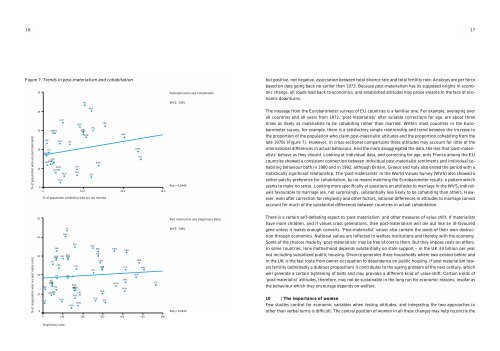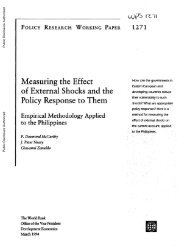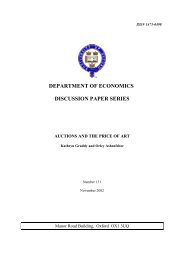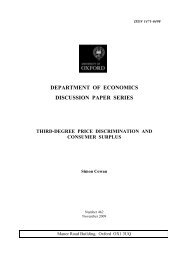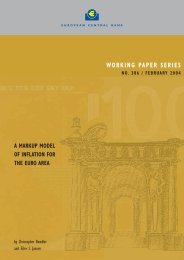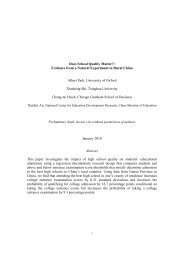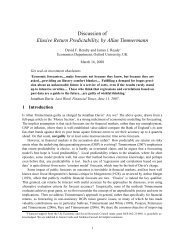Item.pdf - University of Oxford
Item.pdf - University of Oxford
Item.pdf - University of Oxford
You also want an ePaper? Increase the reach of your titles
YUMPU automatically turns print PDFs into web optimized ePapers that Google loves.
16<br />
Figure 7. Trends in post-materialism and cohabitation<br />
% <strong>of</strong> population who are post materialist<br />
% <strong>of</strong> respondents who are post mater ialist<br />
50<br />
40<br />
30<br />
20<br />
10<br />
0<br />
50<br />
40<br />
30<br />
20<br />
10<br />
0<br />
0<br />
SWI<br />
IRE<br />
ROM<br />
FRG<br />
100<br />
illegitimacy ratio<br />
FRG<br />
NL<br />
BEL<br />
ITA ESP<br />
SWI FRA<br />
NL<br />
LIT<br />
BEL<br />
ESP ITA<br />
JAP POL<br />
AP<br />
IRE<br />
KOR<br />
LIT<br />
ESPITA<br />
POR<br />
POL JAP<br />
BUL<br />
AUT<br />
USA UK<br />
ROM<br />
RUS<br />
HUN<br />
BLR<br />
BLR<br />
UK<br />
BEL<br />
IRE<br />
POR<br />
BUL NOR<br />
GDR<br />
LAT<br />
SLO<br />
% <strong>of</strong> population cohabiting who are not married<br />
LAT<br />
RUS<br />
HUN<br />
HUN<br />
200<br />
NL<br />
BEL<br />
SWI<br />
10,0<br />
CAN<br />
FRG<br />
FIN<br />
EST<br />
AUT<br />
FRA<br />
FIN<br />
SLO<br />
NOR<br />
FIN<br />
CAN<br />
USA<br />
UK<br />
SLO<br />
300<br />
FRA<br />
EST<br />
DEN<br />
400<br />
500<br />
600<br />
Post materialism and Illegitimacy Ratio<br />
WVS: 1981<br />
0 Rsq = 0,0072<br />
NOR<br />
SWE<br />
20,0<br />
GDR<br />
ICE<br />
SWE<br />
NOR<br />
DEN<br />
DEN<br />
ICE<br />
SWE<br />
SWE<br />
ICE<br />
30,0<br />
Postmaterialism and Cohabitation<br />
WVS: 1991<br />
Rsq = 0,0445<br />
but positive, not negative, association between total divorce rate and total fertility rate. Analyses are per force<br />
based on data going back no earlier than 1973. Because post-materialism has its supposed origins in economic<br />
change, all roads lead back to economics, and established attitudes may prove volatile in the face <strong>of</strong> economic<br />
downturns.<br />
The message from the Eurobarometer surveys <strong>of</strong> EU countries is a familiar one. For example, averaging over<br />
all countries and all years from 1972, ‘post-materialists’ after suitable corrections for age, are about three<br />
times as likely as materialists to be cohabiting rather than married. Within most countries in the Eurobarometer<br />
survey, for example, there is a satisfactory simple relationship and trend between the increase in<br />
the proportion <strong>of</strong> the population who claim post-materialist attitudes and the proportion cohabiting from the<br />
late 1970s (Figure 7). However, in cross-sectional comparisons these attitudes may account for little <strong>of</strong> the<br />
international differences in actual behaviour. And the more disaggregated the data, the less that ‘post-materialists’<br />
behave as they should. Looking at individual data, and correcting for age, only France among the EU<br />
countries showed a consistent connection between individual post-materialist sentiments and individual cohabiting<br />
behaviour both in 1980 and in 1992, although Britain, Greece and Italy also ended the period with a<br />
statistically significant relationship. The ‘post-materialists’ in the World Values Survey (WVS) also showed a<br />
rather patchy preference for cohabitation, by no means matching the Eurobarometer results, a pattern which<br />
seems to make no sense. Looking more specifically at questions on attitudes to marriage in the WVS, individuals<br />
favourable to marriage are, not surprisingly, substantially less likely to be cohabiting than others. However,<br />
even after correction for religiosity and other factors, national differences in attitudes to marriage cannot<br />
account for much <strong>of</strong> the substantial differences between countries in actual cohabitation.<br />
There is a certain self-defeating aspect to ‘post-materialism’ and other measures <strong>of</strong> value shift. If materialists<br />
have more children, and if values cross generations, then post-materialism will die out like an ill-favoured<br />
gene unless it makes enough converts. ‘Post-materialist’ values also contain the seeds <strong>of</strong> their own destruction<br />
through economics. National values are reflected in welfare institutions and thereby with the economy.<br />
Some <strong>of</strong> the choices made by ‘post-materialists’ may be free <strong>of</strong> cost to them. But they impose costs on others.<br />
In some countries, lone motherhood depends substantially on state support – in the UK £4 billion per year<br />
not including subsidized public housing. Divorce generates three households where two existed before and<br />
in the UK is the fast route from owner-occupation to dependence on public housing. If post materialism lowers<br />
fertility (admittedly a dubious proposition) it contributes to the ageing problem <strong>of</strong> the next century, which<br />
will generate a certain tightening <strong>of</strong> belts and may provoke a different kind <strong>of</strong> value-shift. Certain kinds <strong>of</strong><br />
‘post-materialist’ attitudes, therefore, may not be sustainable in the long run for economic reasons, ins<strong>of</strong>ar as<br />
the behaviour which they encourage depends on welfare.<br />
10 | The importance <strong>of</strong> women<br />
Few studies control for economic variables when testing attitudes, and integrating the two approaches in<br />
other than verbal terms is difficult. The central position <strong>of</strong> women in all these changes may help reconcile the<br />
17


